EDUC 5311: Selective Mutism, Pavlov's Theory, and Intervention
VerifiedAdded on 2022/10/09
|6
|1305
|3
Homework Assignment
AI Summary
This assignment analyzes the condition of selective mutism in children, defining it as an inability to speak in social settings, often stemming from anxiety or mood disorders. It explores the psychological triggers, particularly social anxiety, and examines how Pavlov's classical conditioning theory can explain the occurrence of selective mutism, using terms like conditioned, unconditioned, and neutral stimuli. The assignment further discusses how a classroom teacher can help a child with selective mutism based on Pavlov's theory, referencing behavioral interventions like stimulus fading, systematic desensitization, and shaping, alongside psychodynamic and multimodal approaches that involve parents, teachers, and specialists to facilitate communication and overcome social phobia. The solution is based on the provided resources including a newspaper article and a research paper.
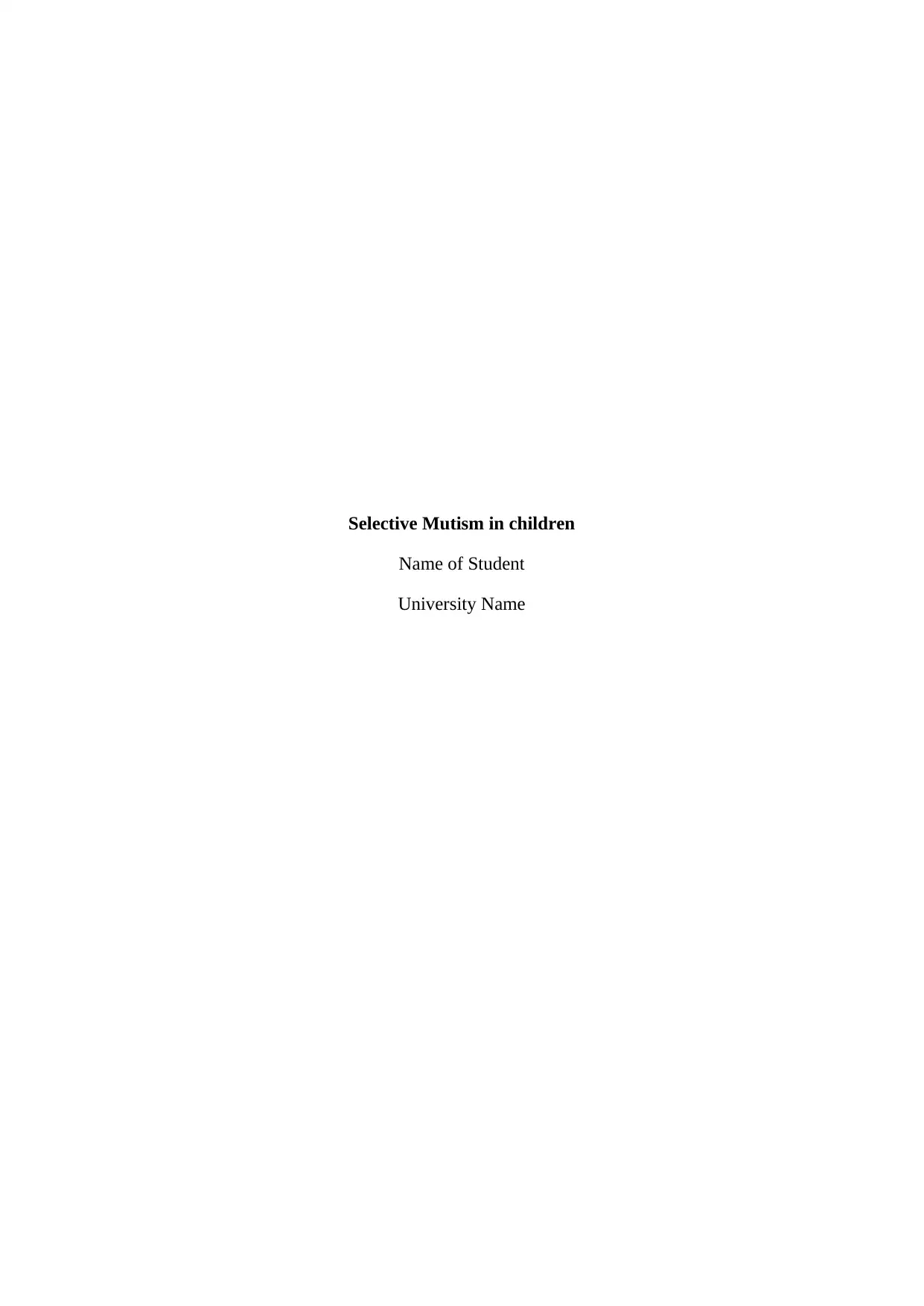
Selective Mutism in children
Name of Student
University Name
Name of Student
University Name
Paraphrase This Document
Need a fresh take? Get an instant paraphrase of this document with our AI Paraphraser
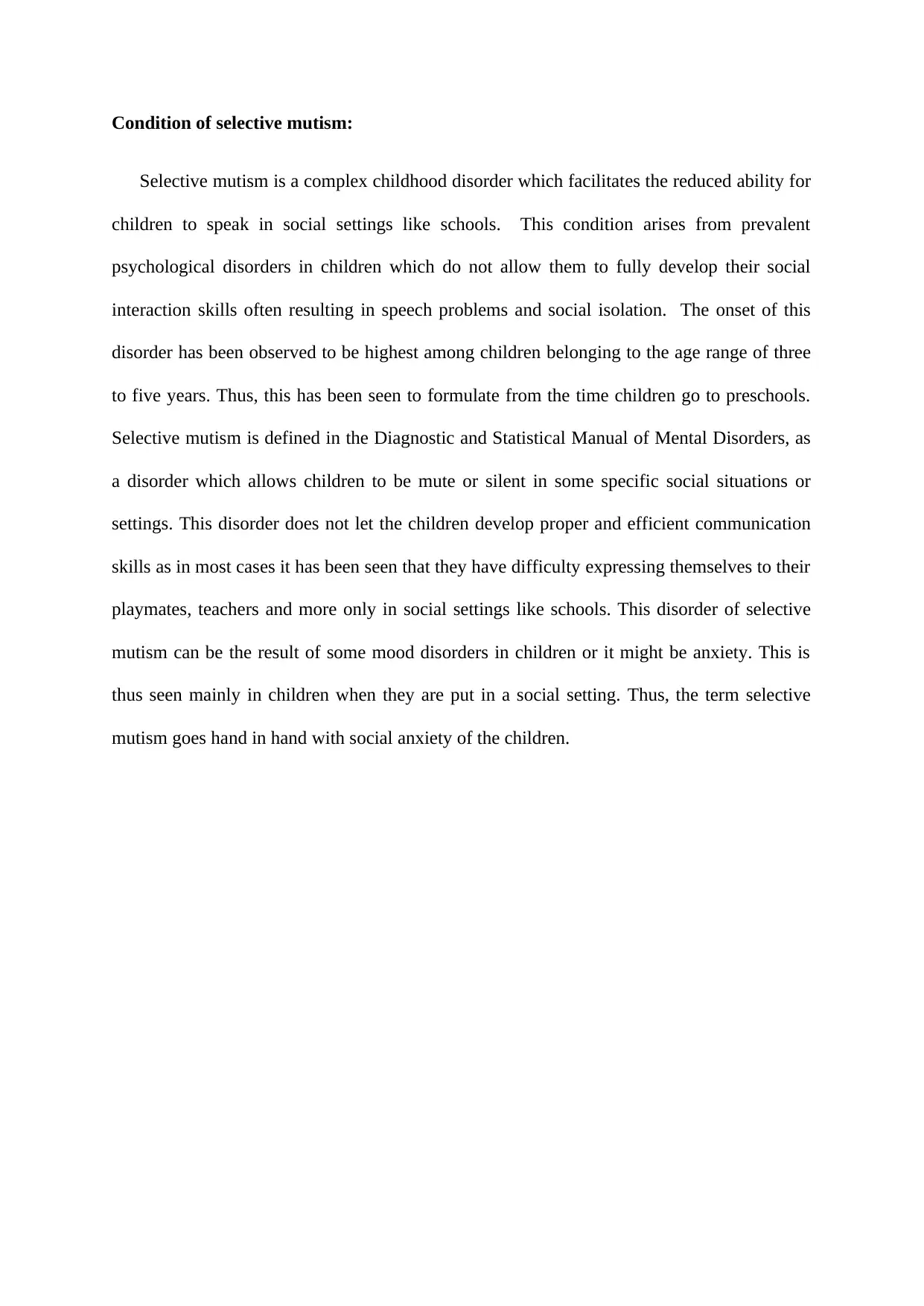
Condition of selective mutism:
Selective mutism is a complex childhood disorder which facilitates the reduced ability for
children to speak in social settings like schools. This condition arises from prevalent
psychological disorders in children which do not allow them to fully develop their social
interaction skills often resulting in speech problems and social isolation. The onset of this
disorder has been observed to be highest among children belonging to the age range of three
to five years. Thus, this has been seen to formulate from the time children go to preschools.
Selective mutism is defined in the Diagnostic and Statistical Manual of Mental Disorders, as
a disorder which allows children to be mute or silent in some specific social situations or
settings. This disorder does not let the children develop proper and efficient communication
skills as in most cases it has been seen that they have difficulty expressing themselves to their
playmates, teachers and more only in social settings like schools. This disorder of selective
mutism can be the result of some mood disorders in children or it might be anxiety. This is
thus seen mainly in children when they are put in a social setting. Thus, the term selective
mutism goes hand in hand with social anxiety of the children.
Selective mutism is a complex childhood disorder which facilitates the reduced ability for
children to speak in social settings like schools. This condition arises from prevalent
psychological disorders in children which do not allow them to fully develop their social
interaction skills often resulting in speech problems and social isolation. The onset of this
disorder has been observed to be highest among children belonging to the age range of three
to five years. Thus, this has been seen to formulate from the time children go to preschools.
Selective mutism is defined in the Diagnostic and Statistical Manual of Mental Disorders, as
a disorder which allows children to be mute or silent in some specific social situations or
settings. This disorder does not let the children develop proper and efficient communication
skills as in most cases it has been seen that they have difficulty expressing themselves to their
playmates, teachers and more only in social settings like schools. This disorder of selective
mutism can be the result of some mood disorders in children or it might be anxiety. This is
thus seen mainly in children when they are put in a social setting. Thus, the term selective
mutism goes hand in hand with social anxiety of the children.
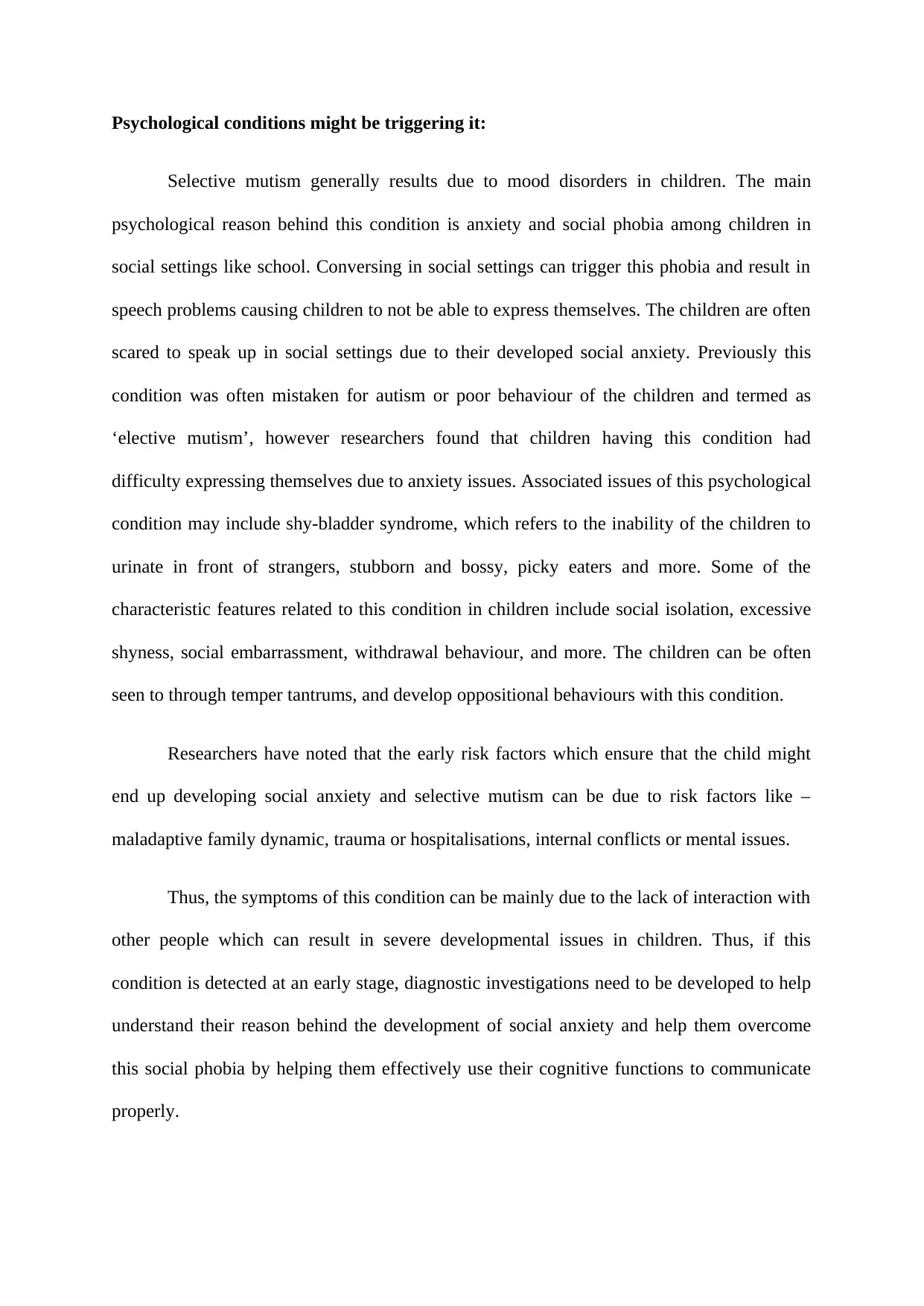
Psychological conditions might be triggering it:
Selective mutism generally results due to mood disorders in children. The main
psychological reason behind this condition is anxiety and social phobia among children in
social settings like school. Conversing in social settings can trigger this phobia and result in
speech problems causing children to not be able to express themselves. The children are often
scared to speak up in social settings due to their developed social anxiety. Previously this
condition was often mistaken for autism or poor behaviour of the children and termed as
‘elective mutism’, however researchers found that children having this condition had
difficulty expressing themselves due to anxiety issues. Associated issues of this psychological
condition may include shy-bladder syndrome, which refers to the inability of the children to
urinate in front of strangers, stubborn and bossy, picky eaters and more. Some of the
characteristic features related to this condition in children include social isolation, excessive
shyness, social embarrassment, withdrawal behaviour, and more. The children can be often
seen to through temper tantrums, and develop oppositional behaviours with this condition.
Researchers have noted that the early risk factors which ensure that the child might
end up developing social anxiety and selective mutism can be due to risk factors like –
maladaptive family dynamic, trauma or hospitalisations, internal conflicts or mental issues.
Thus, the symptoms of this condition can be mainly due to the lack of interaction with
other people which can result in severe developmental issues in children. Thus, if this
condition is detected at an early stage, diagnostic investigations need to be developed to help
understand their reason behind the development of social anxiety and help them overcome
this social phobia by helping them effectively use their cognitive functions to communicate
properly.
Selective mutism generally results due to mood disorders in children. The main
psychological reason behind this condition is anxiety and social phobia among children in
social settings like school. Conversing in social settings can trigger this phobia and result in
speech problems causing children to not be able to express themselves. The children are often
scared to speak up in social settings due to their developed social anxiety. Previously this
condition was often mistaken for autism or poor behaviour of the children and termed as
‘elective mutism’, however researchers found that children having this condition had
difficulty expressing themselves due to anxiety issues. Associated issues of this psychological
condition may include shy-bladder syndrome, which refers to the inability of the children to
urinate in front of strangers, stubborn and bossy, picky eaters and more. Some of the
characteristic features related to this condition in children include social isolation, excessive
shyness, social embarrassment, withdrawal behaviour, and more. The children can be often
seen to through temper tantrums, and develop oppositional behaviours with this condition.
Researchers have noted that the early risk factors which ensure that the child might
end up developing social anxiety and selective mutism can be due to risk factors like –
maladaptive family dynamic, trauma or hospitalisations, internal conflicts or mental issues.
Thus, the symptoms of this condition can be mainly due to the lack of interaction with
other people which can result in severe developmental issues in children. Thus, if this
condition is detected at an early stage, diagnostic investigations need to be developed to help
understand their reason behind the development of social anxiety and help them overcome
this social phobia by helping them effectively use their cognitive functions to communicate
properly.
⊘ This is a preview!⊘
Do you want full access?
Subscribe today to unlock all pages.

Trusted by 1+ million students worldwide
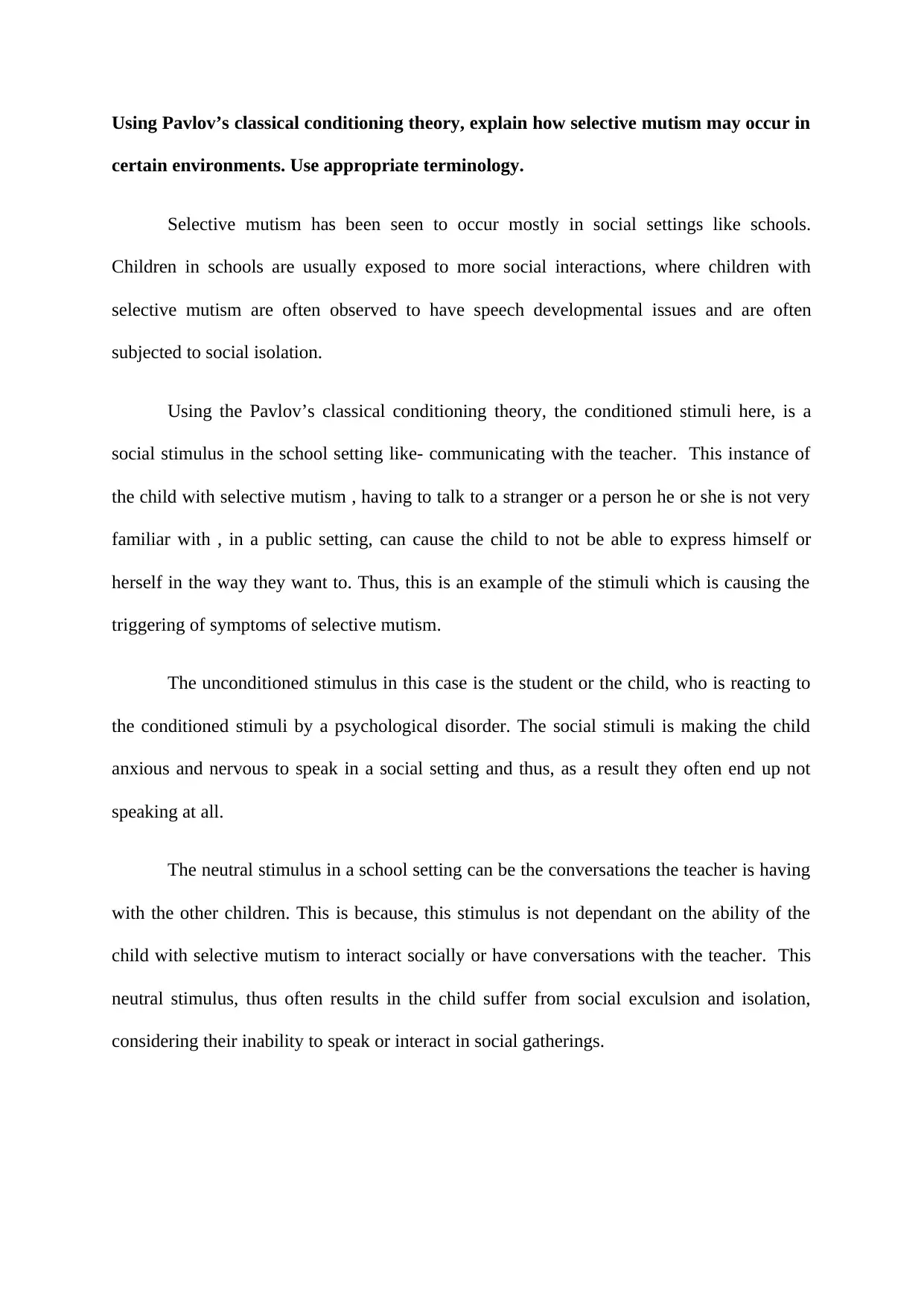
Using Pavlov’s classical conditioning theory, explain how selective mutism may occur in
certain environments. Use appropriate terminology.
Selective mutism has been seen to occur mostly in social settings like schools.
Children in schools are usually exposed to more social interactions, where children with
selective mutism are often observed to have speech developmental issues and are often
subjected to social isolation.
Using the Pavlov’s classical conditioning theory, the conditioned stimuli here, is a
social stimulus in the school setting like- communicating with the teacher. This instance of
the child with selective mutism , having to talk to a stranger or a person he or she is not very
familiar with , in a public setting, can cause the child to not be able to express himself or
herself in the way they want to. Thus, this is an example of the stimuli which is causing the
triggering of symptoms of selective mutism.
The unconditioned stimulus in this case is the student or the child, who is reacting to
the conditioned stimuli by a psychological disorder. The social stimuli is making the child
anxious and nervous to speak in a social setting and thus, as a result they often end up not
speaking at all.
The neutral stimulus in a school setting can be the conversations the teacher is having
with the other children. This is because, this stimulus is not dependant on the ability of the
child with selective mutism to interact socially or have conversations with the teacher. This
neutral stimulus, thus often results in the child suffer from social exculsion and isolation,
considering their inability to speak or interact in social gatherings.
certain environments. Use appropriate terminology.
Selective mutism has been seen to occur mostly in social settings like schools.
Children in schools are usually exposed to more social interactions, where children with
selective mutism are often observed to have speech developmental issues and are often
subjected to social isolation.
Using the Pavlov’s classical conditioning theory, the conditioned stimuli here, is a
social stimulus in the school setting like- communicating with the teacher. This instance of
the child with selective mutism , having to talk to a stranger or a person he or she is not very
familiar with , in a public setting, can cause the child to not be able to express himself or
herself in the way they want to. Thus, this is an example of the stimuli which is causing the
triggering of symptoms of selective mutism.
The unconditioned stimulus in this case is the student or the child, who is reacting to
the conditioned stimuli by a psychological disorder. The social stimuli is making the child
anxious and nervous to speak in a social setting and thus, as a result they often end up not
speaking at all.
The neutral stimulus in a school setting can be the conversations the teacher is having
with the other children. This is because, this stimulus is not dependant on the ability of the
child with selective mutism to interact socially or have conversations with the teacher. This
neutral stimulus, thus often results in the child suffer from social exculsion and isolation,
considering their inability to speak or interact in social gatherings.
Paraphrase This Document
Need a fresh take? Get an instant paraphrase of this document with our AI Paraphraser
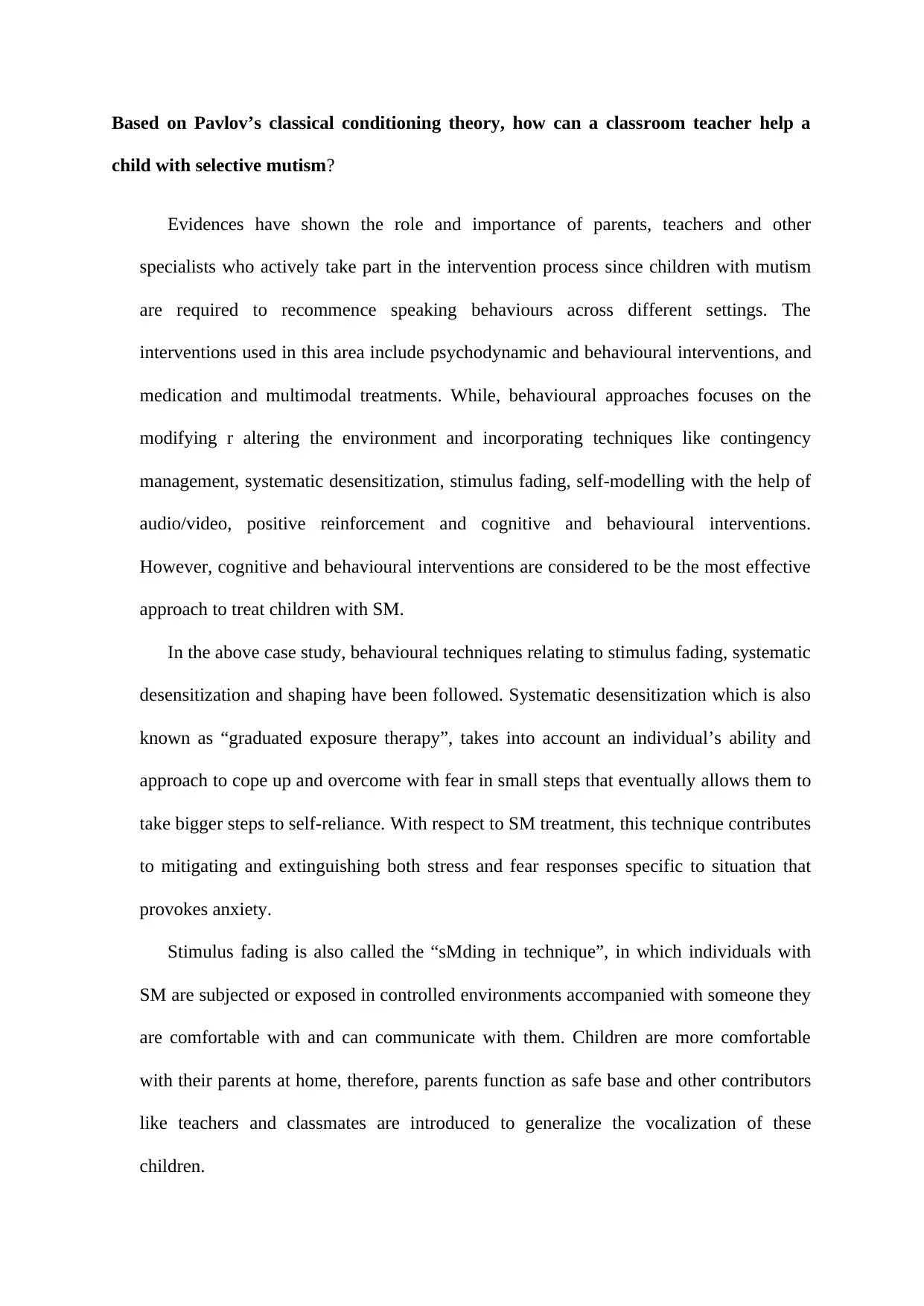
Based on Pavlov’s classical conditioning theory, how can a classroom teacher help a
child with selective mutism?
Evidences have shown the role and importance of parents, teachers and other
specialists who actively take part in the intervention process since children with mutism
are required to recommence speaking behaviours across different settings. The
interventions used in this area include psychodynamic and behavioural interventions, and
medication and multimodal treatments. While, behavioural approaches focuses on the
modifying r altering the environment and incorporating techniques like contingency
management, systematic desensitization, stimulus fading, self-modelling with the help of
audio/video, positive reinforcement and cognitive and behavioural interventions.
However, cognitive and behavioural interventions are considered to be the most effective
approach to treat children with SM.
In the above case study, behavioural techniques relating to stimulus fading, systematic
desensitization and shaping have been followed. Systematic desensitization which is also
known as “graduated exposure therapy”, takes into account an individual’s ability and
approach to cope up and overcome with fear in small steps that eventually allows them to
take bigger steps to self-reliance. With respect to SM treatment, this technique contributes
to mitigating and extinguishing both stress and fear responses specific to situation that
provokes anxiety.
Stimulus fading is also called the “sMding in technique”, in which individuals with
SM are subjected or exposed in controlled environments accompanied with someone they
are comfortable with and can communicate with them. Children are more comfortable
with their parents at home, therefore, parents function as safe base and other contributors
like teachers and classmates are introduced to generalize the vocalization of these
children.
child with selective mutism?
Evidences have shown the role and importance of parents, teachers and other
specialists who actively take part in the intervention process since children with mutism
are required to recommence speaking behaviours across different settings. The
interventions used in this area include psychodynamic and behavioural interventions, and
medication and multimodal treatments. While, behavioural approaches focuses on the
modifying r altering the environment and incorporating techniques like contingency
management, systematic desensitization, stimulus fading, self-modelling with the help of
audio/video, positive reinforcement and cognitive and behavioural interventions.
However, cognitive and behavioural interventions are considered to be the most effective
approach to treat children with SM.
In the above case study, behavioural techniques relating to stimulus fading, systematic
desensitization and shaping have been followed. Systematic desensitization which is also
known as “graduated exposure therapy”, takes into account an individual’s ability and
approach to cope up and overcome with fear in small steps that eventually allows them to
take bigger steps to self-reliance. With respect to SM treatment, this technique contributes
to mitigating and extinguishing both stress and fear responses specific to situation that
provokes anxiety.
Stimulus fading is also called the “sMding in technique”, in which individuals with
SM are subjected or exposed in controlled environments accompanied with someone they
are comfortable with and can communicate with them. Children are more comfortable
with their parents at home, therefore, parents function as safe base and other contributors
like teachers and classmates are introduced to generalize the vocalization of these
children.
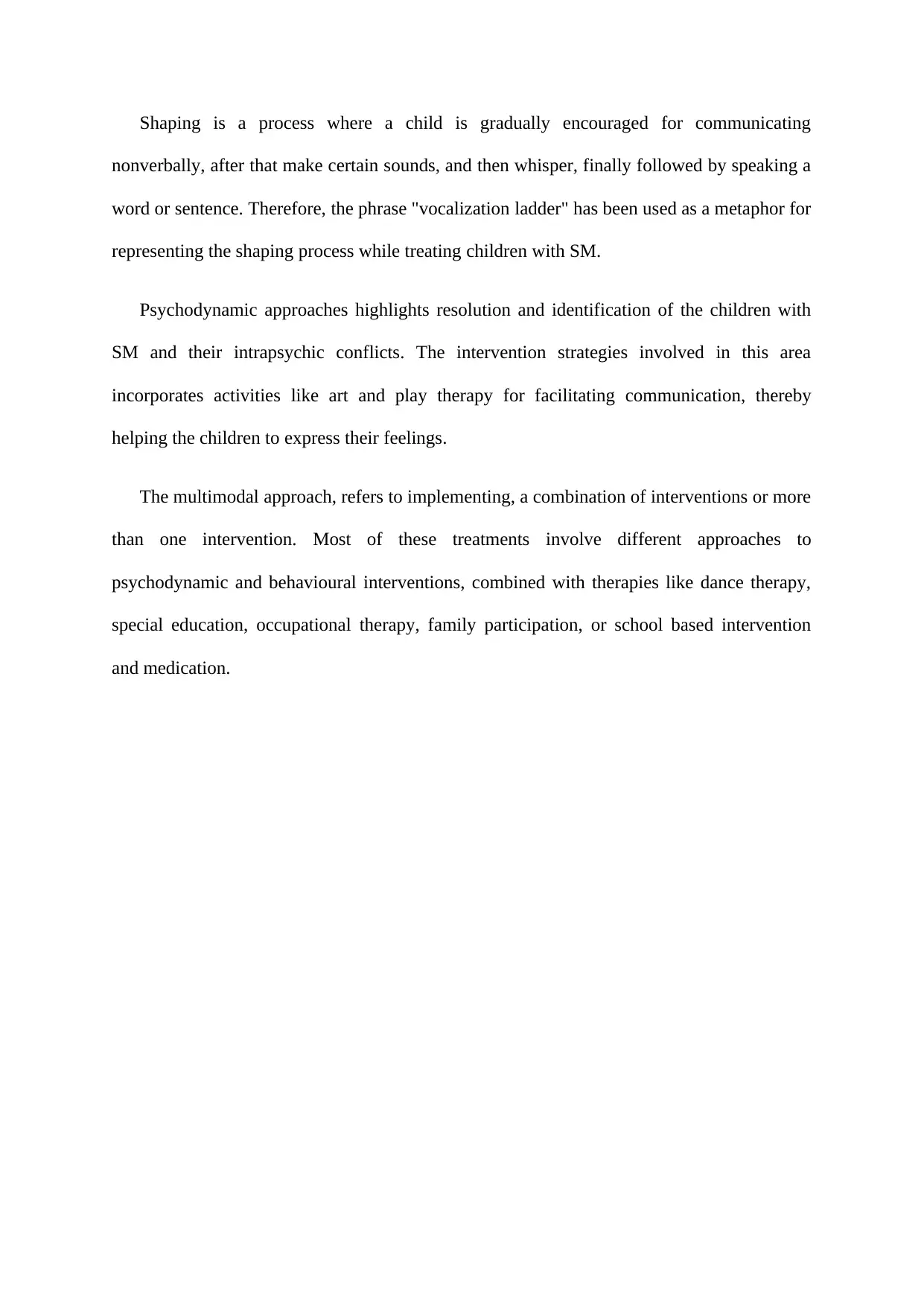
Shaping is a process where a child is gradually encouraged for communicating
nonverbally, after that make certain sounds, and then whisper, finally followed by speaking a
word or sentence. Therefore, the phrase "vocalization ladder" has been used as a metaphor for
representing the shaping process while treating children with SM.
Psychodynamic approaches highlights resolution and identification of the children with
SM and their intrapsychic conflicts. The intervention strategies involved in this area
incorporates activities like art and play therapy for facilitating communication, thereby
helping the children to express their feelings.
The multimodal approach, refers to implementing, a combination of interventions or more
than one intervention. Most of these treatments involve different approaches to
psychodynamic and behavioural interventions, combined with therapies like dance therapy,
special education, occupational therapy, family participation, or school based intervention
and medication.
nonverbally, after that make certain sounds, and then whisper, finally followed by speaking a
word or sentence. Therefore, the phrase "vocalization ladder" has been used as a metaphor for
representing the shaping process while treating children with SM.
Psychodynamic approaches highlights resolution and identification of the children with
SM and their intrapsychic conflicts. The intervention strategies involved in this area
incorporates activities like art and play therapy for facilitating communication, thereby
helping the children to express their feelings.
The multimodal approach, refers to implementing, a combination of interventions or more
than one intervention. Most of these treatments involve different approaches to
psychodynamic and behavioural interventions, combined with therapies like dance therapy,
special education, occupational therapy, family participation, or school based intervention
and medication.
⊘ This is a preview!⊘
Do you want full access?
Subscribe today to unlock all pages.

Trusted by 1+ million students worldwide
1 out of 6
Related Documents
Your All-in-One AI-Powered Toolkit for Academic Success.
+13062052269
info@desklib.com
Available 24*7 on WhatsApp / Email
![[object Object]](/_next/static/media/star-bottom.7253800d.svg)
Unlock your academic potential
Copyright © 2020–2025 A2Z Services. All Rights Reserved. Developed and managed by ZUCOL.





